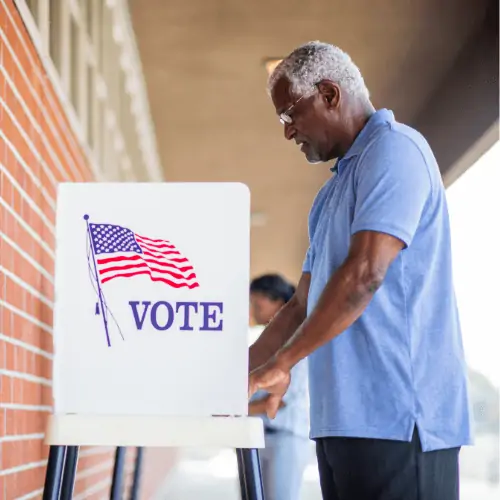Should Employees Receive Time Off for Voting? What Employers Need to Know
October 24th, 2022

Election day is quickly approaching, and employees will be trying to find hours to vote that don’t conflict with their work schedule. While there are no federal laws that require employers to give an employee time off work to vote, 30 states and the District of Columbia all have state laws requiring employers to provide voting leave. Voting leave is an amount of time (sometimes paid time) for employees to vote. Generally, voting leave law requires employers to provide employees with time off to vote during their working hours on election day. This only applies if poll hours don’t provide employees with an opportunity to vote before or after work. Some state laws require employers to give employees advance notice of this option, so they can plan to vote, and some state laws require the time to be paid. MP’s HR experts share considerations employers must know about state laws regarding time off for voting.
Time Off for Voting: 6 Key Considerations for Employers
1. The following states require employers to provide time off for voting:
- Alabama
- Alaska
- Arizona
- Arkansas
- California
- Colorado
- Connecticut
- District of Columbia
- Georgia
- Illinois
- Iowa
- Kansas
- Kentucky
- Maryland
- Massachusetts
- Minnesota
- Missouri
- Nebraska
- Nevada
- New Mexico
- New York
- North Dakota
- Ohio
- Oklahoma
- South Dakota
- Tennessee
- Texas
- Utah
- West Virginia
- Wisconsin
- Wyoming
2. Multi-state employers or employers with remote employees must comply with the laws in every location where they have workers.
This means employers with remote employees or offices in various states must comply with voting leave laws in multiple states. Organizations should work with HR experts, like the ones at MP, to review the voting leave laws that will apply to their teams. It’s also vital for employers to understand when polls open and close. These times, which vary from place to place, often impact the voting leave requirements employers must meet.
3. Include a voting leave policy in your employee handbook.
Once employers have reviewed all voting rights laws that may apply to their employees, updating the employee handbook is vital. Organizations should include voting leave policies for any state(s) where their employees work. The policy language should indicate an employer’s compliance with the relevant laws and list all employee and employer rights. In addition, it should outline the process by which employees take voting leave, notify their managers, and record the time they take off. Laws may even stipulate required components in the policy. (Note that some employers may need to create a state addendum for their handbook to share with employees in the relevant location.) An HR expert will be able to assist with the development of a voting leave policy, as well as executing a plan for disseminating it. Employers should use HR software, like MP’s, to share their employee handbooks and gather acknowledgment pages.
4. Organizations may be required to give employees notice.
Some state laws regarding time off for voting stipulate that employers must share information about employees’ right to take time off for voting. Often organizations should share this information via a poster on the wall in a prominent area, like a break room. For employers with remote employees, this matter becomes a little more complicated. Organizations may distribute voting leave notice(s) electronically to their employees, but they must ensure that employees have access. (For example, employers should not put a notice on a company intranet that is rarely used.) This component is critical for employer compliance, but it also allows employees time to plan and give notice of their time off in advance. Some voting rights laws require employees to give advanced notice of their plans to take voting leave. Even if employees aren’t required to give notice, it still benefits the employer, coworkers, and the employee themselves if everyone knows about the plan to take voting leave ahead of time. Managers can plan ahead if they’ll be short-staffed or need a project or task to be covered.
5. Organizations may need to pay employees for their voting leave.
Some state voting rights laws, such as the ones for Alaska, California, Colorado, and Illinois, may require employers to pay their employees for taking time off for voting. Employers should consider creating separate types of leave in their time and attendance software (like MP’s). Tracking voting leave hours digitally will ensure employers pay for the time accurately and promptly.
6. Incorporate voting leave as part of the company culture.
Whether required or not, employers should consider positioning voting leave as part of the company’s culture and values. An organization can roll out voting leave as an extension of its commitment to work-life balance. It can also be framed as part of an organization’s interest in community service initiatives. Voting is, at its core, about serving the community. If employers want to frame voting leave as a company culture or community service initiative, they should (of course) offer it to all employees. The organization should work with an HR expert to develop a voting leave policy compliant with all state laws. Then, they should roll it out to the whole company. In today’s tight labor market, this strategy may significantly impact employee retention and attract top talent. Employees want to work for companies that value them, value their work-life balance, and have deep, admirable values. Complying with voting leave laws may be an easy way to help an employer meet these expectations, thus attracting and retaining the talent they need.
.
Recent Posts
- Planning for 2026: 5 HR Decisions You Need to Make Before Year-End
- Brokers 2026 Planning Guide: How to Make Your Clients Stick Around
- Part 1 – The 2025 HR Compliance Debrief: The Big Shifts Employers Can’t Ignore
- Part 3 – Turning ACA Data into Strategy: How HR Teams Can Use Compliance Insights to Drive Smarter Benefits Decisions in 2025
- CPA Year-End Checklist: How the Right Payroll Partner Protects Your Client Advisory Practice
Categories
- ACA (10)
- AI (6)
- BizFeed (6)
- Business Strategy (122)
- COBRA (5)
- Compliance (255)
- COVID-19 (92)
- Diversity (12)
- eBooks (19)
- Employee Engagement (33)
- Employee Handbooks (24)
- ERTC (29)
- FFCRA (7)
- HR (314)
- MP Insider (13)
- Payroll (175)
- PFML (9)
- PPP (24)
- PTO (5)
- Recruiting (54)
- Remote Work (39)
- Return to Work (32)
- Unemployment (1)
- Wellness (22)
Archives
- December 2025
- November 2025
- October 2025
- September 2025
- August 2025
- July 2025
- June 2025
- May 2025
- April 2025
- March 2025
- February 2025
- January 2025
- December 2024
- November 2024
- October 2024
- September 2024
- August 2024
- July 2024
- June 2024
- May 2024
- April 2024
- March 2024
- February 2024
- January 2024
- December 2023
- November 2023
- October 2023
- July 2023
- June 2023
- May 2023
- April 2023
- March 2023
- January 2023
- December 2022
- October 2022
- September 2022
- August 2022
- July 2022
- June 2022
- May 2022
- April 2022
- March 2022
- February 2022
- January 2022
- December 2021
- November 2021
- October 2021
- September 2021
- August 2021
- July 2021
- June 2021
- May 2021
- April 2021
- March 2021
- February 2021
- January 2021
- December 2020
- November 2020
- October 2020
- September 2020
- August 2020
- July 2020
- June 2020
- May 2020
- April 2020
- March 2020



